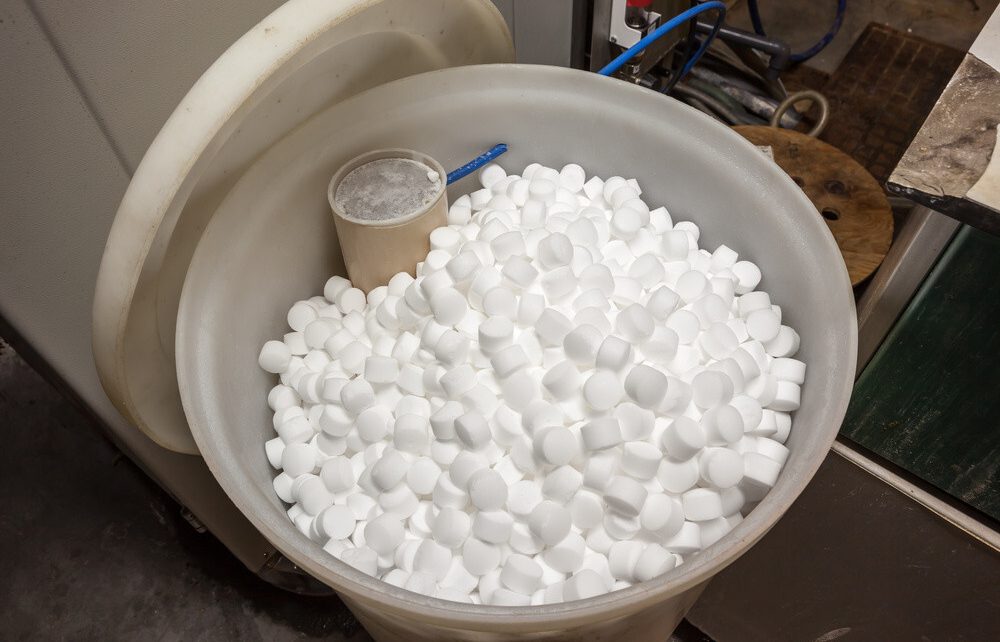The ion-exchange system is by far the most common form of residential water softener. Understanding each part ‘s purpose will help you maintain it properly.
There are three primary components for ion-exchange water softeners: a mineral tank, a brine tank, and a control mechanism. The mineral tank and brine tanks are merged into one cabinet with lower capacity versions, but the two tanks are still divided inside the cabinet.
Larger flow capacity systems have a separate stand-alone mineral and brine tanks:
Mineral tank: Where the activity is, the mineral tank is. That is where the water filtration takes place and, by extracting calcium and magnesium, the rough water is softened.
The brine tank: The brine tank is where sodium or potassium is contained in a extremely concentrated solution. To flush the mineral tank and reload it, this brine solution comes into play. It is important to replenish the brine tank annually with salt or potassium pellets.
Control valve: The control valve is the mechanism that manages water flow during regeneration into and out of the mineral and brine tanks.
In most situations, at the point where the water source reaches the property, a water softener is found and built so that it handles the water used for drinking, heating, and cleaning, but not the water used for outdoor irrigation.
The Mineral Tank
The tall small tank where the real water softening happens is the mineral tank. It is filled with porous plastic polystyrene resin beads containing multiple cubic feet. The negatively charged beads capture and retain the positively charged calcium and magnesium ions in the water as water passes into this tank. The water which flows onward is now soft with these hard minerals trapped by the resin beads.
The beads eventually become saturated with rocks, however, and would have to be washed (regenerated). The next elements of the software are central to the process.
The Brine Tank
Just as the name suggests is the brine tank: a plastic tank holding brine-water saturated with salt or potassium. When it is time to backwash the mineral tank, extract the mineral fragments, and add the negative charge to the beads, this saline water can be used so that they can begin to trap more minerals.
The brine tank is usually kept full of salt ( sodium). However, if you are on a reduced low-sodium diet, complications can occur, since a small amount of sodium is transferred during the regeneration process into the drinking water. And in septic systems that are required for the breakdown of waste, sodium may also affect bacteria. For this cause, in many states and jurisdictions, including Fillmore, CA, Michigan, Texas, and Connecticut, sodium brine has been prohibited or limited. As an option, it is possible to use potassium for brine. Potassium, while a little more costly than salt, is considered superior and environmentally friendly and does not impact the wellbeing, watersheds, or the operation of septic tanks.
The Control Valve and the Regeneration Process
The control valve serves as the traffic cop in your water softener system. It determines when it is time to clean those plastic beads, which are now coated with calcium and magnesium. Older style units use a timer, while newer models use a computer-controlled meter that determines when it is time for regeneration, based on actual water usage.
Control panel water softener
The Regeneration Process
The water softener uses a method also called regeneration, which consists of three cycles: backwash, recharge, and rinse, to clean the beads in the mineral tank. Every few days, this procedure takes place and is usually started in the middle of the night.
Backwash: Regeneration starts with a backwash cycle in which the valve reverses the water flow in the tank and flushes the tank of debris. This debris is then eliminated through the drain connected to the municipal sewer system or septic system.
Recharge (regeneration): In the recharge cycle, the salty solution is pumped from the brine tank into the mineral tank. The highly concentrated salt solution forces the magnesium and calcium off the beads, and the mineral-rich salty water is then flushed out of the tank and down the drain.
Rinse: Then the mineral tank is filled and rinsed with water, the process of regeneration is stopped and the process of water softening repeats itself.
The beads are now coated with sodium or potassium supplied by the brine tank in the newly regenerated mineral tank. The positively charged calcium and magnesium in the water are drawn to the plastic crystals, removing the sodium on the beads, as more rough water reaches the mineral tank. In the bath, this tiny volume of salt displaced from the beads is suspended and goes on into the supply of home water. In general, even for people who have stringent limits on sodium, this small amount of salt in the water is not a concern.
As the beads are saturated with hard-water calcium and magnesium again, a new regeneration period begins with the control valve and flushes the hard-water minerals down the drain again. As long as the brine tank is stocked with salt or potassium pellets, this constant loop continues.

